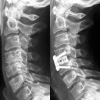Degenerative cervical spinal stenosis: current strategies in diagnosis and treatment
- PMID: 19626174
- PMCID: PMC2696878
- DOI: 10.3238/arztebl.2008.0366
Degenerative cervical spinal stenosis: current strategies in diagnosis and treatment
Abstract
Introduction: Cervical spinal stenosis has become more common because of the aging of the population. There remains much uncertainty about the options for surgical treatment and their indications, particularly in cases of cervical myelopathy.
Methods: In order to provide guidance in clinical decision-making, the authors selectively reviewed the literature, according to the guidelines of the Association of Scientific Medical Societies in Germany.
Results: Cervical myelopathy is a clinical syndrome due to dysfunction of the spinal cord. Its most common cause is spinal cord compression by spondylosis at one or more levels. Its spontaneous clinical course is variable; most patients undergo a slow functional deterioration. Surgical treatment reliably arrests the progression of myelopathy and often even improves the neurological deficits.
Discussion: The available scientific data are too sparse to enable evidence-based treatment of cervical myelopathy. Early surgical intervention is often recommended in the literature. Controversy remains regarding the choice of the appropriate surgical procedure, but there is consensus on the suitable options for many specific clinical situations.
Keywords: anterior decompression; cervical myelopathy; cervical spinal stenosis; posterior decompression; surgical treatment.
Figures



Similar articles
-
Update of the Natural History, Pathophysiology, and Treatment Strategies of Degenerative Cervical Myelopathy: A Narrative Review.Asian Spine J. 2023 Feb;17(1):213-221. doi: 10.31616/asj.2022.0440. Epub 2023 Feb 15. Asian Spine J. 2023. PMID: 36787787 Free PMC article.
-
Degenerative Cervical Myelopathy: Pathophysiology and Current Treatment Strategies.Asian Spine J. 2020 Oct;14(5):710-720. doi: 10.31616/asj.2020.0490. Epub 2020 Oct 14. Asian Spine J. 2020. PMID: 33108837 Free PMC article.
-
[Influence of Cervical Spondylotic Spinal Cord Compression on Cerebral Cortical Adaptation. Radiological Study].Acta Chir Orthop Traumatol Cech. 2015;82(6):404-11. Acta Chir Orthop Traumatol Cech. 2015. PMID: 26787180 Czech.
-
An Evidence-Based Stepwise Surgical Approach to Cervical Spondylotic Myelopathy: A Narrative Review of the Current Literature.World Neurosurg. 2016 Oct;94:97-110. doi: 10.1016/j.wneu.2016.06.109. Epub 2016 Jul 5. World Neurosurg. 2016. PMID: 27389939 Review.
-
The Natural History of Degenerative Cervical Myelopathy.Neurosurg Clin N Am. 2018 Jan;29(1):21-32. doi: 10.1016/j.nec.2017.09.002. Epub 2017 Oct 27. Neurosurg Clin N Am. 2018. PMID: 29173433 Review.
Cited by
-
Perioperative Complications of Surgery for Degenerative Cervical Myelopathy: A Comparison Between 3 Procedures.Global Spine J. 2023 Mar;13(2):432-442. doi: 10.1177/2192568221998306. Epub 2021 Mar 12. Global Spine J. 2023. PMID: 33709809 Free PMC article.
-
Internal morphology of human facet joints: comparing cervical and lumbar spine with regard to age, gender and the vertebral core.J Anat. 2012 Mar;220(3):233-41. doi: 10.1111/j.1469-7580.2011.01465.x. Epub 2012 Jan 18. J Anat. 2012. PMID: 22257304 Free PMC article.
-
Comparison of inter- and intra-observer reliability among the three classification systems for cervical spinal canal stenosis.Eur Spine J. 2017 Sep;26(9):2290-2296. doi: 10.1007/s00586-017-5187-3. Epub 2017 Jun 13. Eur Spine J. 2017. PMID: 28612191
-
Sudden spinal cord injury after cervicothoracic manipulation therapy: illustrative case.J Neurosurg Case Lessons. 2025 Aug 11;10(6):CASE25304. doi: 10.3171/CASE25304. Print 2025 Aug 11. J Neurosurg Case Lessons. 2025. PMID: 40789223 Free PMC article.
-
Integration of MRI and somatosensory evoked potentials facilitate diagnosis of spinal cord compression.Sci Rep. 2023 May 15;13(1):7861. doi: 10.1038/s41598-023-34832-2. Sci Rep. 2023. PMID: 37188786 Free PMC article.
References
-
- Teresi LM, Lufkin RB, Reicher MA, Moffit BJ, Vinuela FV, Wilson GM, et al. Asymptomatic degenerative disc disease and spondylosis of the cervical spine: MR imaging. Radiology. 1987;164:83–88. - PubMed
-
- Patil PG, Turner DA, Pietrobon R. National trends in surgical procedures for degenerative cervical spine disease: 1990-2000. Neurosurgery. 2005;57:753–758. - PubMed
-
- Lang J. Funktionelle Anatomie der Halswirbelsäule und des benachbarten Nervensystems. In: Hohmann D, Kügelgen B, Liebig K, Schirmer M, editors. Neuroorthopädie. Band 1. Berlin, Heidelberg, New York, Tokyo: Springer; 1983. pp. 1–118.
-
- Chiles BW, Leonard MA, Choudhri HF, Cooper PR. Cervical spondylotic myelopathy: patterns of neurological deficit and recovery after anterior cervical decompression. Neurosurgery. 1999;44:762–769. - PubMed
-
- White AA, Panjabi MM. Biomechanical considerations in the surgical management of cervical spondylotic myelopathy. Spine. 1988;13:856–860. - PubMed
LinkOut - more resources
Full Text Sources
Other Literature Sources

